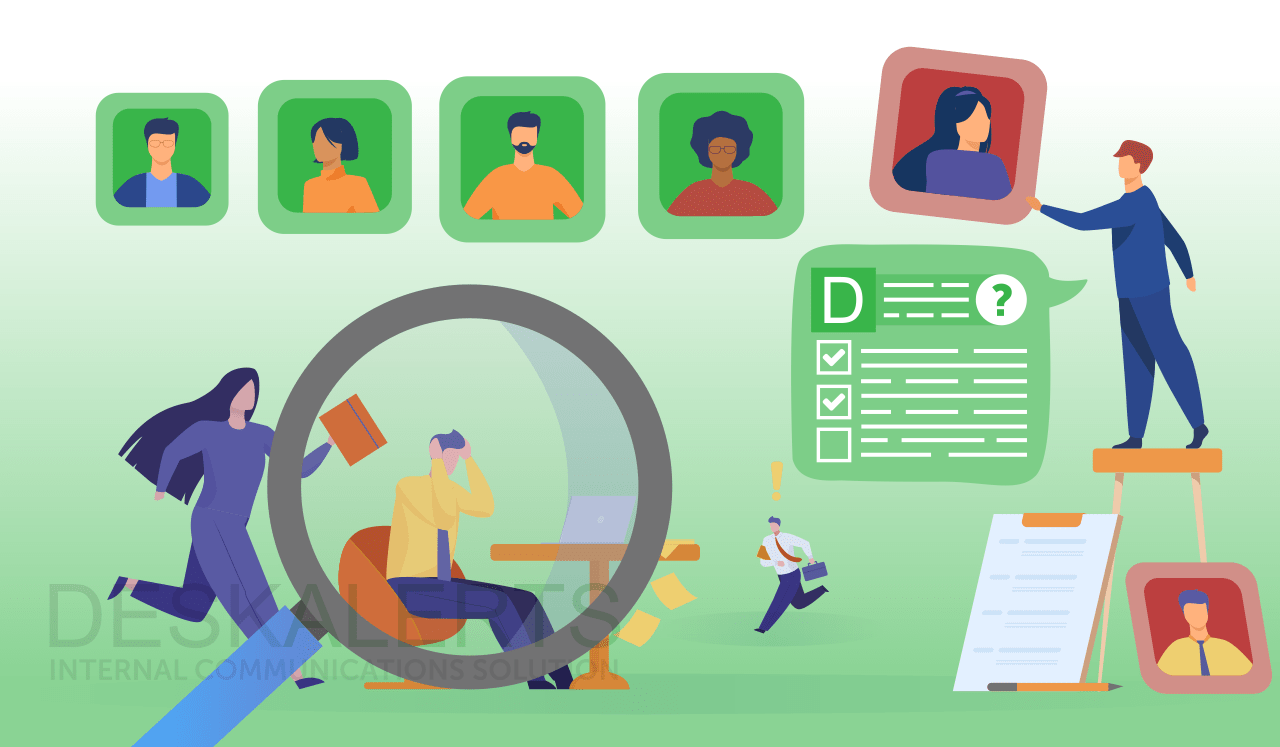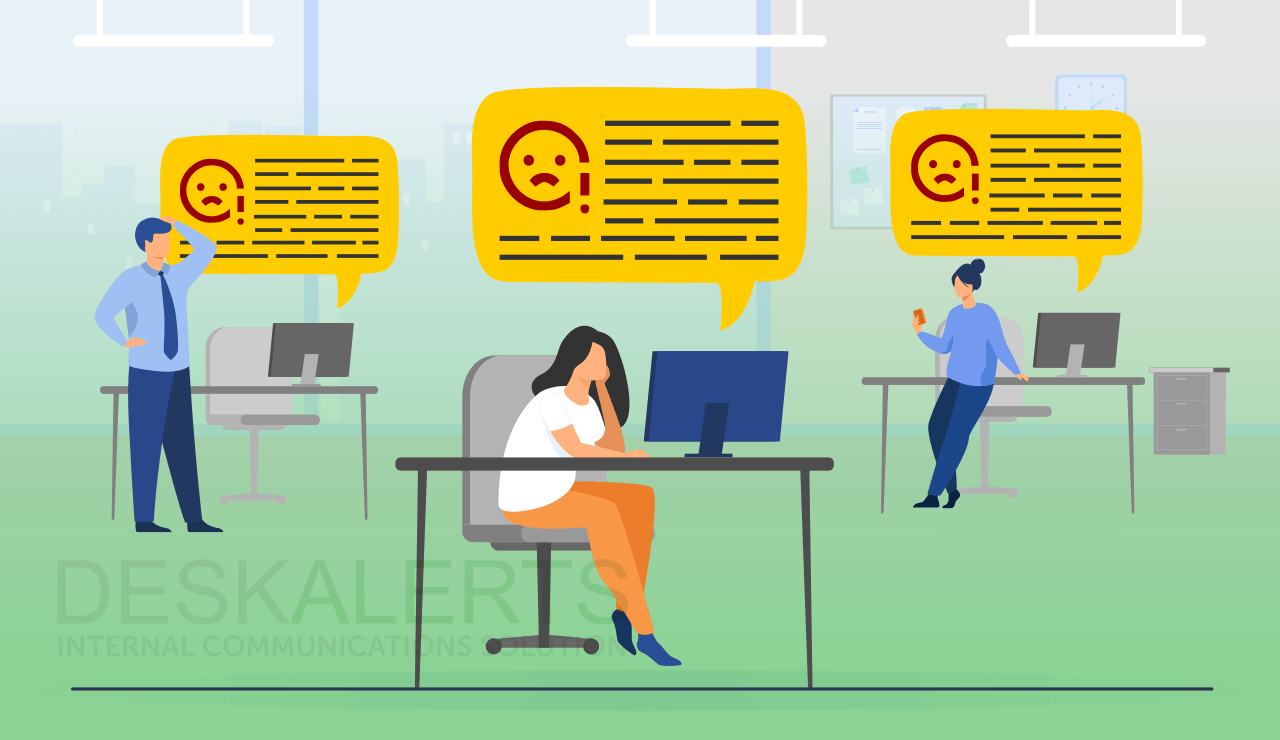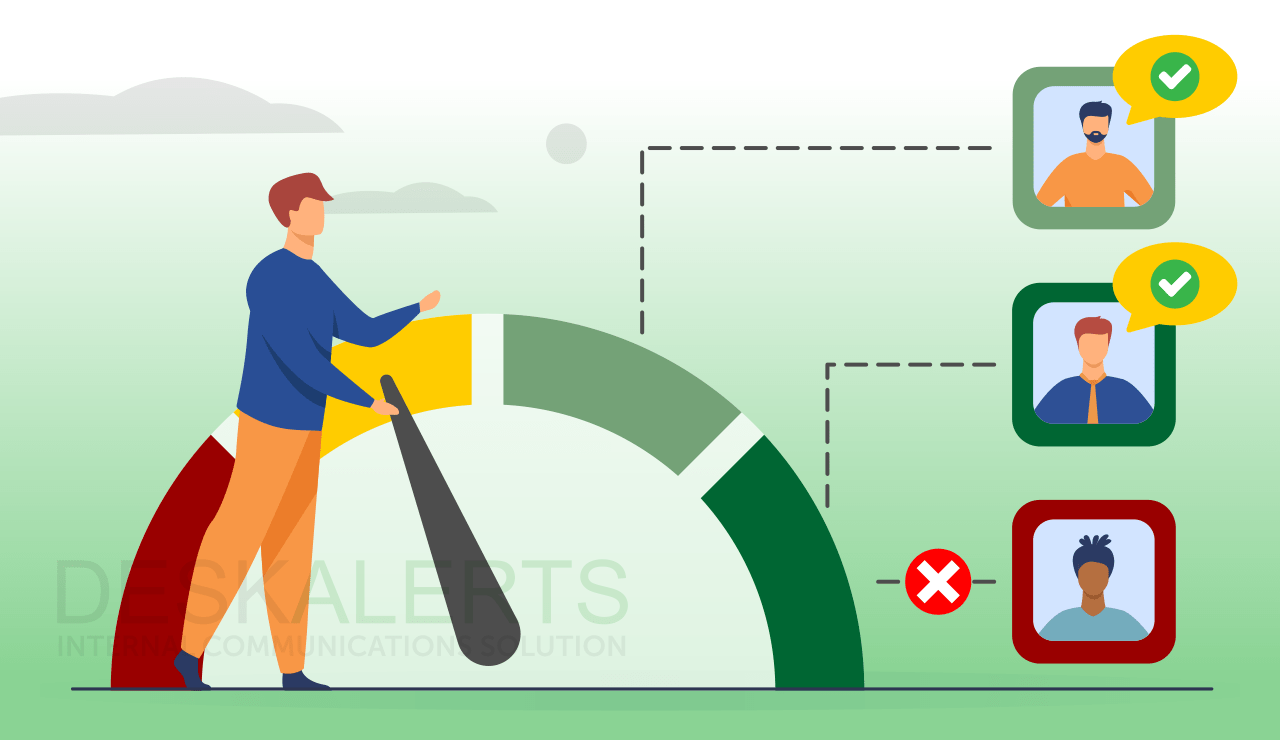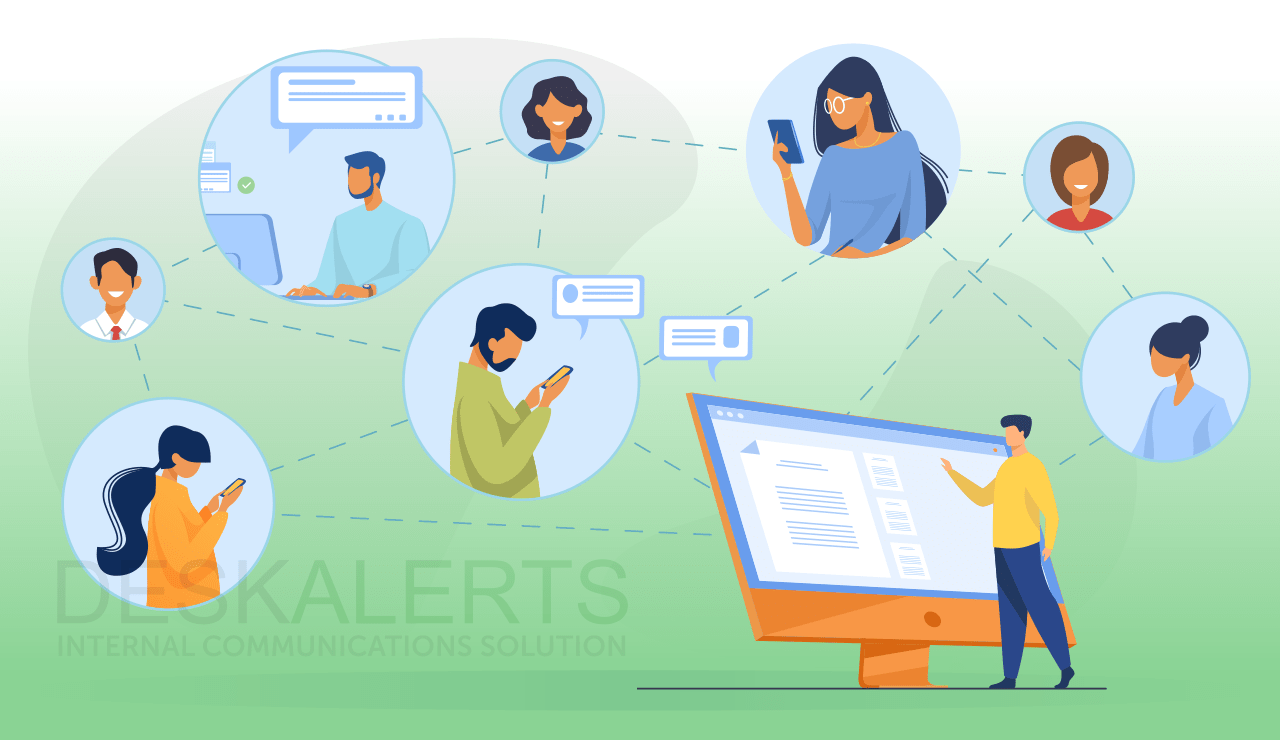
The digital workplace experience – the way your employees are linked in with digital systems in the workplace – contributes to their overall experience of being part of the company. The way that they interact with the technology, how reliable it is, how easy it is to use, how it helps them to access information and data and how it helps them be productive and efficient all combine to create an overall digital employee experience.
This digital employee experience can include:
- Digital workflows (are there too many steps to complete a task?)
- The adoption of new technology in the workplace
- Being given timely access to systems during onboarding
- Being given appropriate training in new systems
- Reliability and usability of user interfaces of digital tools.
Table of contents
The difference between employee experience and digital experience
Why is digital employee experience important?
What contributes to a great digital employee experience?
Common issues that affect the digital employee experience
Who is responsible for the digital workplace employee experience?
The factors that influence the digital employee experience
How to improve the digital workforce experience in your company
How to measure digital employee experience
The difference between employee experience and digital experience
There can be some confusion between the “employee experience” and the “digital employee experience”. These two terms are closely related but are not interchangeable.
The “employee experience” is used to describe an employee’s experience with the company throughout the lifecycle of their tenure on the team. This includes:
- Any communication in the pre-hire process
- The recruitment process
- Onboarding
- Orientation
- Training and development
- The work environment
- The off-boarding process (get employee offboarding checklist)
The digital employee experience, on the other hand, is focused on the employees’ interactions with the digital workplace and the tools that they use. Some of the “employee experience” items may also have some cross-over in that they use digital tools, so this shouldn’t be overlooked.
Why is digital employee experience important?
Today, digital technology has taken over many aspects of peoples’ personal lives. From banking to watching movies and listening to music, to shopping online, booking tickets and more. People are used to having technology work quickly and assist them to get things done. And if something doesn’t work, people will find a new solution.
Unfortunately, the digital workplace experience many people have doesn’t always function this way. Employees can be frustrated by systems that are arduous and antiquated and processes that take too long. And they can’t just change to a simpler more efficient digital system because they have to work with the systems and software the company provides.
In addition, employees want to be able to work easily remotely when they need to, and as well as the ability to access workplace systems from their own devices.
Research has found that 71% of employees want their company to provide them with the same level of technology that they are using in their personal lives.
There are direct links between business success and the digital workplace employee experience. When employees are happy with their digital experience, the company benefits. This can include:
- Increased levels of employee satisfaction
- More engaged employees
- An increase in staff retention rates
- Making your business an employer of choice with staff likely to recommend it as a great place to work
- Increases in productivity and profitability
- More efficiencies and streamlined workflows.
A 2017 study from The Future of Work University found that organizations that invest in the employee experience have up to four times more average profit and two times the average revenue of organizations that don’t.
Another survey from Vason Bourne found that employees who feel their company provides a great digital experience are much more likely to recommend their company to others as a great place to work. In terms of attracting talent, 73% of respondents said that the flexibility of tools such as technology, apps and devices used by a company would influence their decision to apply for or even accept a position there.
What contributes to a great digital employee experience?
If you want to create a great digital workplace, you should consider some of these digital employee experience examples:
- Using modern digital tools and other technology that are easy to use, easy to implement and will improve productivity.
- Ensure your employees have the skills and training to use the tools you provide.
- Wherever you can, make it personal. Personalization and customization can make technology more user-friendly.
- Communication with employees about the need for the tools that you’re implementing, as well as a mechanism for them to provide feedback on their experience with the rollout of the technology (check out the software rollout plan).
- Standardized use of new systems across the workplace: if people aren’t using the same tools, it makes teamwork difficult.
Common issues that affect the digital employee experience
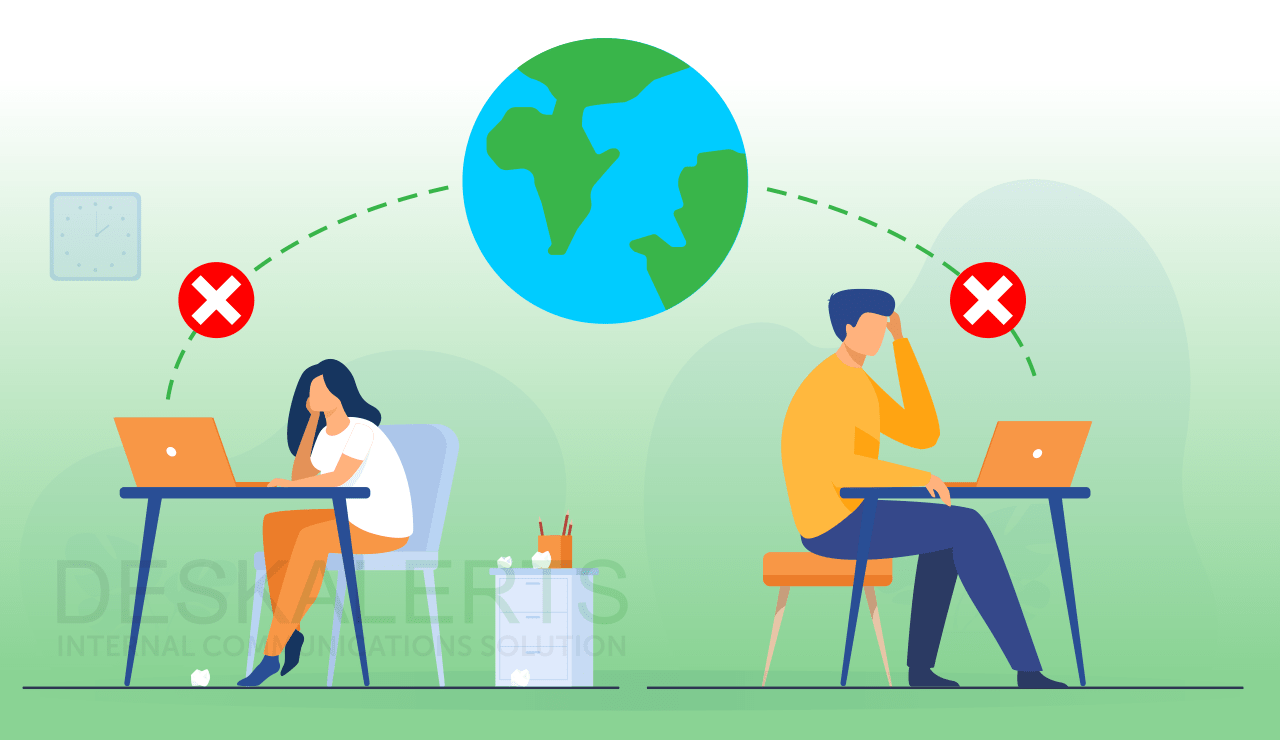
The experience employees have with digital tools in the workplace is dependent on many factors. Some common issues include:
1. Not having the best digital tools for the job.
This is one of the major sore points for employees who have issues with the digital experience in their workplace.
Your employees have an expectation they will be provided with best practice software that is straightforward, easy to use and makes their life easier. But sometimes companies purchase something that isn’t the top-of-the-line software solution. Employees don’t want to take five minutes to do something that another software package would let them achieve in seconds.
Sometimes a cheaper software alternative isn’t really cheaper. When it doesn’t come with the same features of a competitor product that could save your employees time, you actually end up costing yourself more in the long term. Especially if they are used to using the better software or tools at a previous job.
2. IT departments not updating software and systems
With so many work functions increasingly being online, employees need reliable systems that are updated regularly by the IT team. Sometimes they may need to access websites - for example for training, or to participate in a video conference with an outside organization using different software to the one that is used in-house. Only they are unable to do so because they get an error message saying that the browser they are using is old and unsupported.
Further frustration happens as a result of the way that IT departments control updates and upgrades - they can’t simply fix it themselves like they would on a home computer.
3. Custom software that isn’t fit-for-purpose
I once worked in an organization that decided to reinvent SharePoint. The reason being was that someone in the IT team didn’t like using it… so they spent many months building a new alternative to SharePoint to deploy across the organization in a spectacular case of digital transformation not being comparable with employee experience.
They didn’t consult with employees before they took the old system away, so they didn’t realize the amount of disruption that was going to happen when people could no longer find the information that they needed, or just no longer had the features they used regularly. In addition to this, the user interface was not intuitive. Instead of making things easier in the organization, it actually decreased the employee digital experience significantly.
4. Inefficient systems and processes
For many of us, it might seem like a relic of a bygone era, but there are people who still use fax machines! There are lots of other outdated technologies still in place across different organizations, which slow people down.
Other times the low levels of tech in the workplace impose digital limitations, meaning that there is still a lot of reliance on paper-based systems and processes.
Email, which itself was once seen as being an exciting alternative to the fax machine, has also become a burden. Email overload - where employees find they get too many messages each day and can’t keep up with the volume of their inboxes - has become a modern problem that affects the digital workplace employee experience.
5. Difficulty finding information
Whether it's finding files or trying to locate policies and procedures on the intranet, many company systems are difficult to navigate and even more difficult to search. People want to be able to find information quickly and easily, and far too often they are unable to.
6. Not being set up properly from the start
IT onboarding for the new employees is a requirement to get right for many reasons.
When there are reliable and consistent employee onboarding processes in place, organizations can improve their new hire retention by as much as 82%, according to research by Glassdoor.
Unfortunately, many organizations fail to set their employees up for success from day one. Sometimes employees don’t even have a desk or computer on their first day, let alone systems access or an email address. My husband once waited for five weeks when he started a job to get a desk telephone - and a major part of his job was calling people!
In addition to the basics, employees want to be trained in using the systems they’ll be expected to use, and to be shown how to access important information like applying for leave or logging their hours or finding their payslips.
Download free IT onboarding check-list

7. Organizations fail to see the problem
Many organizations are either unaware of this issue or don’t think it's a high priority. As a result, they don’t have any plans to change, which allows frustration and dissatisfaction to fester.
Who is responsible for the digital workplace employee experience?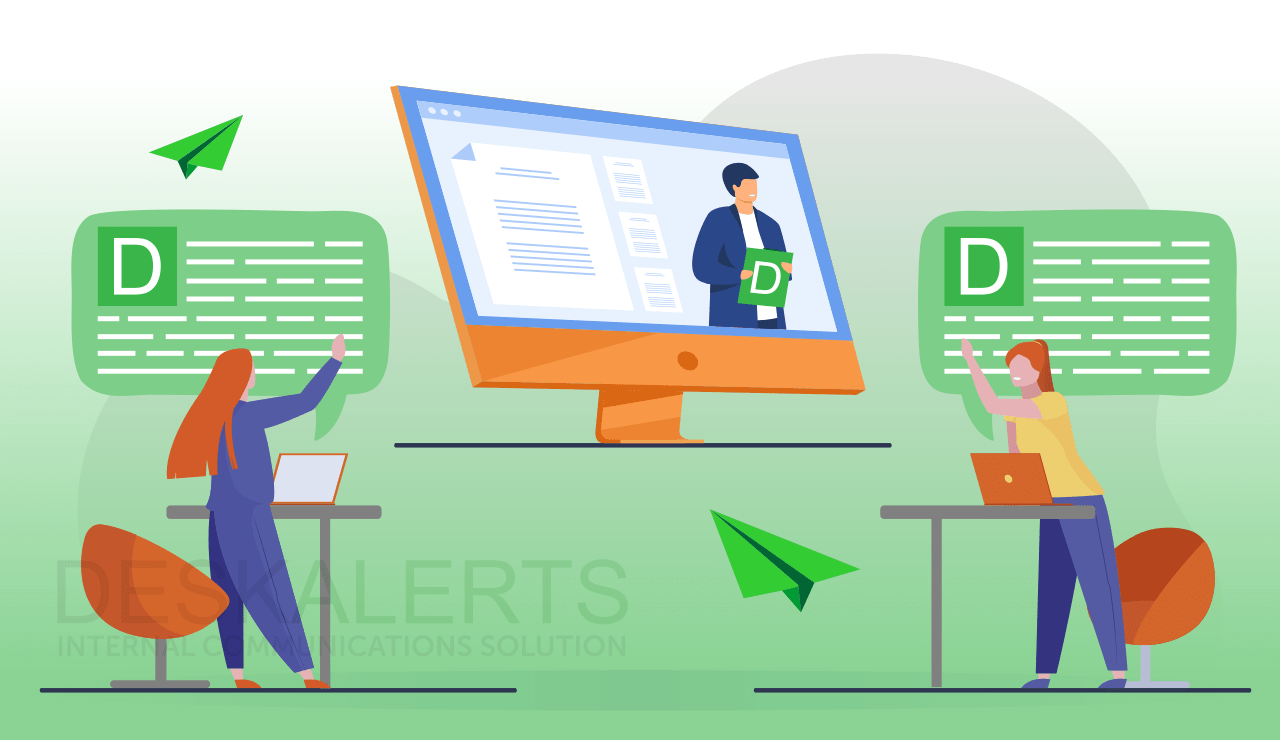
A recent global digital employee experience survey carried out by Step Two found that the intranet team, the IT team, internal communications team and digital team within organizations are generally responsible for digital employee experience management.
It makes sense for employee digital experience
to be championed by one team, but to have the buy-in from other teams within the organization. Senior leadership and Human Resources should also be involved. In some organizations, change management teams may be the ones responsible for this function as improving employee digital experience is a major change program they are delivering.
The factors that influence the digital employee experience
Every organization is different. Even two organizations in the same industry will have major differences in terms of workplace culture, resources, budgets, aims and objectives. This contributes to both the employee experience and the employee digital experience within the company.
- Use of digital tools: Technology is driving change in workplaces and when used effectively can really boost productivity and profitability. Having the right tools for the right job that are easy to use can set your employees up to succeed.
- Ensuring employees have current skills: Getting the technology implemented is just the first step. You need to ensure that your employees are properly trained to use the tools that you provide so that you get the most benefit from your investment. You may also find that not all employees have good digital literacy, while others are digital natives. Finding a balance to cater for everyone is essential.
Establishing effective work processes: With an investment in new technology and skilling your employees up to use it properly, the next factor in ensuring you get bang for your buck is to create workflows and other work processes to streamline your activities and save time - getting the most out of your new systems.
How to improve the digital workforce experience in your company
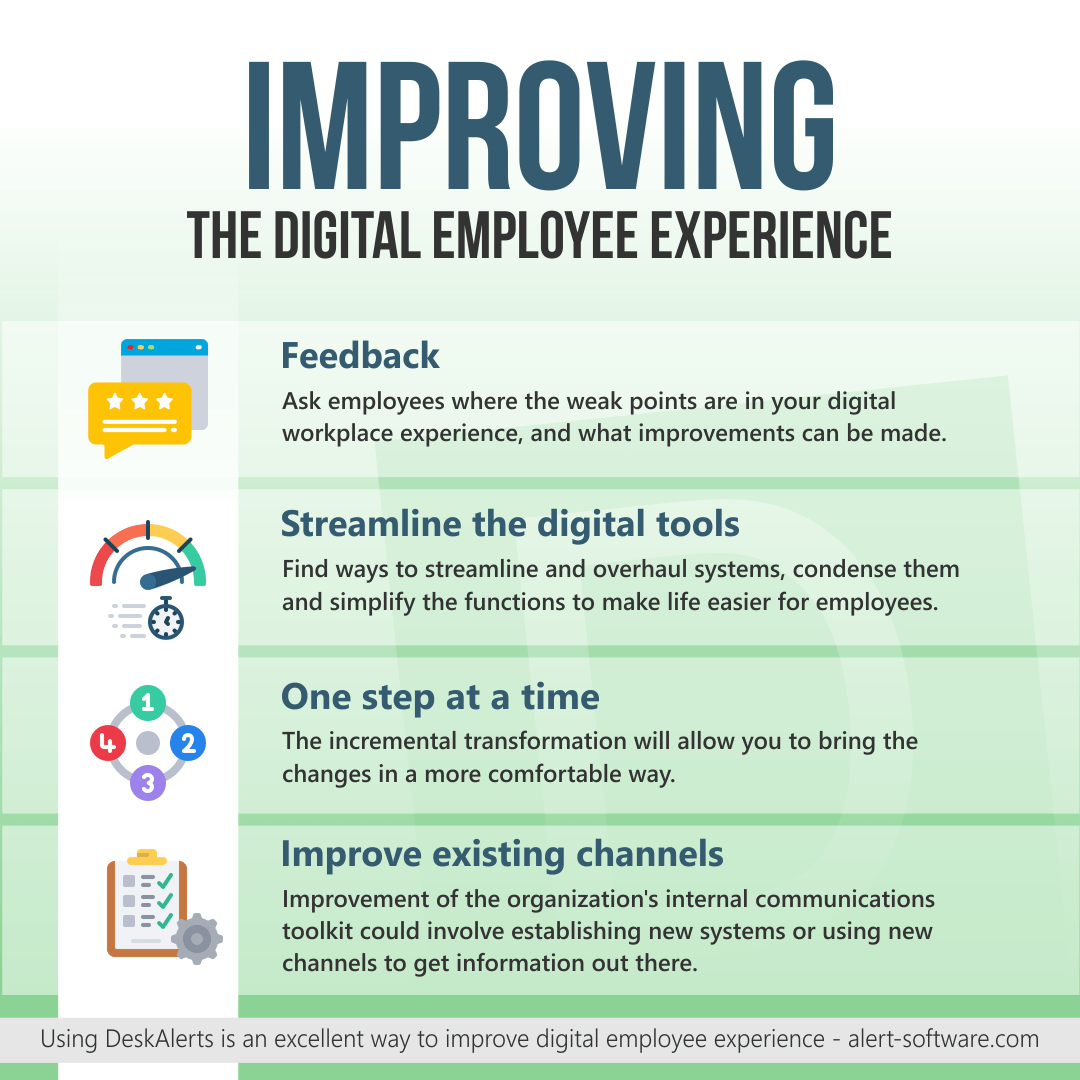
The types of technology and solutions needed to improve the employee digital experience within your company will generally be dictated by the industry that you are in and the type of work that you do.
There are, however, steps to take to address common issues across the board when you’re building a roadmap to change:
1. Get feedback from staff
You can’t fix problems you don’t know about. Getting feedback from employees can help. you identify where the weak points are in your digital workplace experience, and what improvements can be made.
Similarly, don’t change systems without consulting with employees first!
2. Look at ways to streamline your digital tools
In some companies employees have too many different tools and software systems to use every day. There may be ways to streamline and overhaul systems, condense them and simplify the functions to make life easier for employees.
3. Don’t change too much at once
If you do have to implement new systems, overhauling everything at once can overwhelm your employees - especially as not everyone will have the same levels of IT proficiency and ability to learn new software quickly. The incremental transformation will allow you to bring the changes in a more comfortable way.
4. Look at improving your communications channels
Many of the frustrations with digital tools in the workplace boil down to people not being given the information that they need or being unable to find it. Look at ways of improving the way the company provides information to employees. Improvement of the organization's internal communications toolkit could involve establishing new systems or using new channels to get information out there.
This should be embedded in the work that all teams do to communicate among themselves, and to other teams.
>> Learn more about the employee engagement and communication <<

How to measure digital employee experience
You can’t improve your company's digital employee experience if you don’t have a way to measure it. This can help you to determine if your organization is getting a positive return on the investment it has made into the digital employee experience.
There are a few different ways to do this, using both qualitative and quantitative methods.
Qualitative methods, where you ask employees how they feel about their digital experience, are of course subjective and can’t easily be quantified. But combined with other types of data you may have available, you can build a better picture of what examples of the digital employee experience might actually be.
To determine your company’s digital employee experience, you should follow these steps:
1. Determine the digital employee experience baseline
You have no way of knowing if anything has improved if you don’t know the point you’re starting from. Creating a baseline will ensure that you have a way of accurately measuring any future success or failure in this space.
There are different types of data you can gather to determine the baseline:
- IT data - for example how long it takes people to log on to devices, system crashes, web browser crashes, downtime, connectivity problems, antivirus issues and critical business application freezes.
- HR data - look at statistics on recruitment and retention: do people leave your organization quickly? What do they say in their exit interviews?
- Direct answers from employees - this can take the form of employee pulse surveys, face-to-face consultations or focus groups to determine where the pain points are for employees, or examples of what aspects of the digital employee experience they enjoy and are happy with.
The quantitative and qualitative data can then be analysed to determine how happy your employees are with the digital experience.
2. Benchmark your data
Determine the intervals that you will use to collect the data. Would it be an annual exercise or more often, such as quarterly or twice a year. What is the best practice for measuring the digital employee experience in your industry? It might be more frequent, and you should factor this into your own benchmarking process.
3. Recognize the improvements that need to be made
Once you have collected the data in your benchmarking exercises, you can compare it with the baseline data to determine whether or not any improvements your company has made to boost the digital employee experience have been successful or not.
If you recognize there is still room for improvement, you can look at fine-tuning and enhancing your digital experience even more.
You may find there are consistent and ongoing issues with software or hardware that employees are experiencing.
4. Look at the findings from the employees’ point of view
Management can sometimes have a disconnect from employees and be focused on different things. Listen to what your employees are telling you - particularly where they give explicit examples of their experience - and envisage what it might be like to have these frustrations while trying to do your job. They don’t want to hear excuses for why their systems don’t work properly, they want you to understand and to take meaningful steps to improve things.
A PWC study of more than 12,000 workers found a major disconnect between how leaders and their staff perceive technological tools. It found that 90% of the C-suite executives who participated in the study felt that their companies paid attention to what their employees needed when they introduced new technology. However only 53% of employees said the same.
5. Devise a strategy for improvements
Once you have the data you need, you can now outline the changes that you plan on making in order to improve the digital experience for your employees. Your strategy should outline the problems that your employees are experiencing, the steps you will take to fix these problems and when you will deliver the improvements.
Once you have implemented the measures in your strategy, you can once more examine the data to determine its effectiveness and begin the process again if needed.
***
If you haven’t already given thought to how your organization’s digital environment is structured, can you afford to put off doing so? In order to remain competitive, efficient, productive and profitable and to keep your employees engaged and happy, you need to ensure they have the right tools to do their jobs.
FAQ
What is digital employee experience?
Employees in most industries rely on technology to some extent in order to carry out their work. The term digital employee experience is used to analyze the effectiveness of digital tools in the workplace in terms of how employees engage and interact with them. There is a direct link between the usefulness of digital tools and overall productivity in an organization. People expect technology that is straightforward, easy to use and fit-for-purpose – they are used to this in their personal lives when it comes to technology, and expect the same standard at work.
How can digital employee experience be improved?
There are several factors you should take into account when it comes to improving the digital employee experience in your workplace:
- Make sure your digital tools are strategic and in alignment with both the company’s goals and employee needs.
- Involve the right stakeholders from different parts of the company to ensure you deliver the right experience.
- Include all the key parts of the lifecycle of an employee in your organization.
- Understand your employees, their pain points, the way they work, their preferences and their needs.
- Provide tailored individual experiences and personalization where you can (try to create employee persona to better understand what they need).
Why is digital employee experience important?
It’s important to deliver a great digital employee experience to ensure that your workforce has the best possible tools to make them productive and efficient. Your digital tools should make it easier for employees to do their jobs, not harder. Badly designed technology and digital interfaces can be time-consuming to use.
If your workplace technology isn’t up to the job, it can cause stress and resentment, slow your employees down or they might just stop using some of the tools entirely. It can even lead to so much frustration that your company’s overall culture and morale can suffer, as can your employee retention.
 Caroline Duncan
Caroline Duncan










